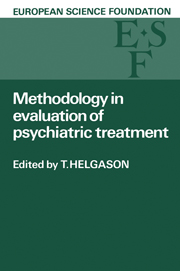 Methodology in Evaluation of Psychiatric Treatment
Methodology in Evaluation of Psychiatric Treatment Book contents
- Frontmatter
- Contents
- Participants
- Foreword
- Preface
- INTRODUCTION
- I METHODS OF CLASSIFICATION
- II EVALUATION CRITERIA
- III RATING METHODS IN EVALUATION OF TREATMENT
- TheAMP Rating Methods
- The Comprehensive Psychopathological Rating Scale (CPRS)
- The Use of Rating Scales for Affective Disorders
- Self-Rating Scales in the Evaluation of Psychiatric Treatment
- Methods for Measuring Social Adjustment
- IV OTHER QUANTITATIVE METHODS OFEVALUATION OF TREATMENT
- V ETHICALAND PRACTICAL PROBLEMS
- Index
Self-Rating Scales in the Evaluation of Psychiatric Treatment
from III - RATING METHODS IN EVALUATION OF TREATMENT
- Frontmatter
- Contents
- Participants
- Foreword
- Preface
- INTRODUCTION
- I METHODS OF CLASSIFICATION
- II EVALUATION CRITERIA
- III RATING METHODS IN EVALUATION OF TREATMENT
- TheAMP Rating Methods
- The Comprehensive Psychopathological Rating Scale (CPRS)
- The Use of Rating Scales for Affective Disorders
- Self-Rating Scales in the Evaluation of Psychiatric Treatment
- Methods for Measuring Social Adjustment
- IV OTHER QUANTITATIVE METHODS OFEVALUATION OF TREATMENT
- V ETHICALAND PRACTICAL PROBLEMS
- Index
Summary
Introduction
The primary goal of psychiatric treatment is to cure or, at least, to improve mental disorders at the lowest possible risk for the patient. The reduction of symptoms usually serves as a measure of success in reaching this goal. Therefore, the quantification of psychiatric symptoms is a basic requirement for the evaluation of the efficacy of therapeutic efforts. The introduction ofmodern psychopharmacological treatment and also that of behaviour therapy in psychiatry has stimulated the development of a psychopathometric approach (von Zerssen 1980; von Zerssen & Moller 1980) which is surveyed comprehensively by Cronholm & Daly in this volume. The authors rightly point out that, with respect to rating procedures, “self-rating may be complementary to expert rating”, because “different aspects may be observed and the sources of error” are different (von Zerssen & Cording 1978). In the following paper these statements will be commented on in more detail.
General considerations
As compared with expert rating (Mombour 1972; Pichot & Olivier-Martin 1974), self-rating is simpler because it does not require highly skilled specialists (well-trained psychiatrists or clinical psychologists) as raters; the patients themselves rather perform the task of indicating the presence or absence of disturbances and, in some rating scales, also that of marking their degree (frequencylintensity). The disturr bances in question are usually specified in a questionnaire whether for one global rating (e.g. that of ‘inner tension’) or for the rating of several (up to more than 100)items. They may also be presented in a graphical form as in the Visual Analogue Scale (Luria 1975).
Scale values are derived from the patient's check marks on the question naire, using a ‘key’ which can be programmed for electronic data processing. The scoring procedure is thus executed only by the patient, by technical personnel, and, if available, by a computer. The scale values may be based on a global rating or, as sum-scores, on a number of scores obtained from individual items. In unidimensional scales, the items of a questionnaire all belong to one construct (e.g. ‘anxiety’), in two- or multidimensional scales, they are distributed among two or more constructs (e.g. ‘anxiety’, ‘hostility’ and the like). Generally, the constructs are either conceived as clinical syndromes or represent dimensions of factorial analyses of questionnaire items. This is also analogous to the conception of clinical rating scales.
- Type
- Chapter
- Information
- Methodology in Evaluation of Psychiatric TreatmentProceedings of a Workshop Held in Vienna 10–13 June 1981, pp. 183 - 204Publisher: Cambridge University PressPrint publication year: 1983


